Beviser på udlændinge? Hvad skal man gøre ved forskning og rapportering om Oumuamua, vores besøgende fra rummet
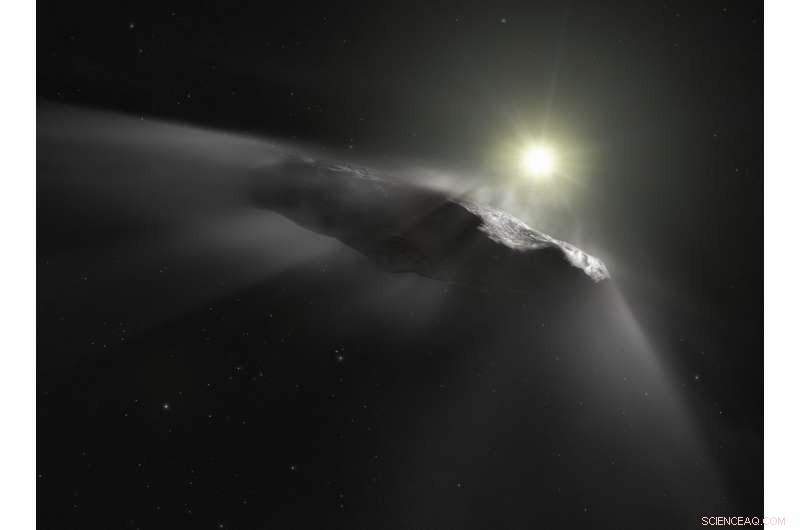
En kunstners indtryk af 'Oumuamua, det første interstellare objekt opdaget i solsystemet. ESA/Hubble, NASA, ESO, M. Kornmesser, CC BY
Som astrofysiker, nok det mest almindelige spørgsmål, jeg bliver stillet, er:"Er vi alene i universet, og eksisterer rumvæsner?"
Der er ingen tvivl:Folk elsker at tænke og tale om rumvæsener. Derfor, historier om søgen efter udenjordisk intelligens bliver samlet op og rapporteret med velbehag i medierne.
Men det, der virkelig ligger i hjertet af dette komplicerede og populære emne, er beviser – karakteren af ethvert bevis på fremmed liv, hvordan vi ser på og respekterer disse beviser, og hvordan dette formidles til offentligheden.
Ingen steder er dette vigtigere end i dækningen af videnskabelige undersøgelser af et mystisk objekt - 'Oumuamua - der for nylig blev opdaget passerer gennem vores solsystem. For eksempel, to udgivelser i to respekterede peer-reviewede tidsskrifter affødte meget forskellige reaktioner.
Hej 'Oumuamua
'Oumuamua, betyder spejder eller budbringer på hawaiiansk, er navnet på det første opdagede interstellare objekt, der besøgte vores solsystem. Ved opdagelse sidste år, 'Oumuamua blev klassificeret som en komet, men dette blev senere trukket tilbage, da der ikke blev påvist noget bevis for kometaktivitet.
'Oumuamua viste sig hurtigt at have en bane, der ikke tilhører vores solsystem. Det har en oprindelse et andet sted i vores galakse, og en bane, der så den krydse det indre solsystem i løbet af et par måneder.
Den passerede tæt på solen og jorden, og viste sig at have en usædvanlig geometri, omkring 200 meter lang og omkring 35 meter bred, roterer hver syvende time.
Opdagelsen af 'Oumuamua skabte megen opmærksomhed i det videnskabelige samfund, og i medierne. I betragtning af dens usædvanlige geometri og dens oprindelse uden for solsystemet, spørgsmål blev hurtigt stillet om 'Oumuamua kunne være et rumfartøj.
Observationer blev foretaget med radioteleskoper for at søge efter direkte beviser for transmissioner, der indikerer intelligent liv, herunder af et hold ledet af mig ved hjælp af et australsk teleskop (Murchison Widefield Array). Vi lyttede omkring FM-radiofrekvenser, på grundlag af, at ethvert intelligent liv på 'Oumuamua kan genkende FM-frekvenser, der er populære på Jorden.
Der blev aldrig fundet noget direkte bevis på intelligent liv i disse søgninger.
Flere hårde data om 'Oumuamua
Omfattende og imponerende observationer med en række teleskoper, inklusive Hubble-rumteleskopet, blev lavet for nøjagtigt at bestemme 'Oumuamuas bane. Resultaterne af undersøgelsen, af et hold astronomer ledet af Den Europæiske Rumorganisations Marco Micheli, blev offentliggjort i Nature i juni.
Disse meget omhyggelige observationer viste, at 'Oumuamua accelererede, da den forlod solsystemet, afslører eksistensen af "ikke-gravitationskræfter". Det betyder, at objektets bane ikke kunne forklares kun ved solens tyngdekraft og andre større genstande i vores solsystem.
Der findes en række mulige forklaringer på accelerationen. Den ene er, at opvarmet gas, der undslipper fra 'Oumuamua (udgassing), kunne producere en kraft, der forårsagede den observerede acceleration. Dette ses almindeligvis hos normale kometer.
Men 'Oumuamua viser stadig ingen beviser for kometaktivitet. Michelis team gennemgik seks mulige forklaringer og konkluderede, at udgasning er den mest sandsynlige mulighed, selvom der ikke er direkte beviser for, at det er tilfældet.
De viste, at accelerationen af 'Oumuamua er usædvanlig, men inden for grænserne af, hvad der tidligere er set for solsystemets kometer.
En af de forklaringer, som undersøgelsesholdet diskonterede, er, at 'Oumuamua blev accelereret af strålingstryk fra vores sol. Stråling fra solen kan skubbe genstande væk fra den.
But they concluded that this explanation is not preferred, because it means that the density of 'Oumuamua would have to be very low. An object needs have a large surface area and low mass (low density) to be accelerated by radiation pressure.
Could it be aliens?
Another study by postdoctoral researcher Shmuel Bialy and distinguished astronomer Avi Loeb, from Harvard University, took a different approach.
Details of the study have just been published in November's The Astrofysiske journalbreve , but were available online earlier.
The authors chose to assume solar radiation pressure to be the cause of the acceleration, and then determined the properties of 'Oumuamua required to make this work. They require an object with thickness less than 1mm, an areal mass density of 1 to 2 grams per square centimetre, and a large area.
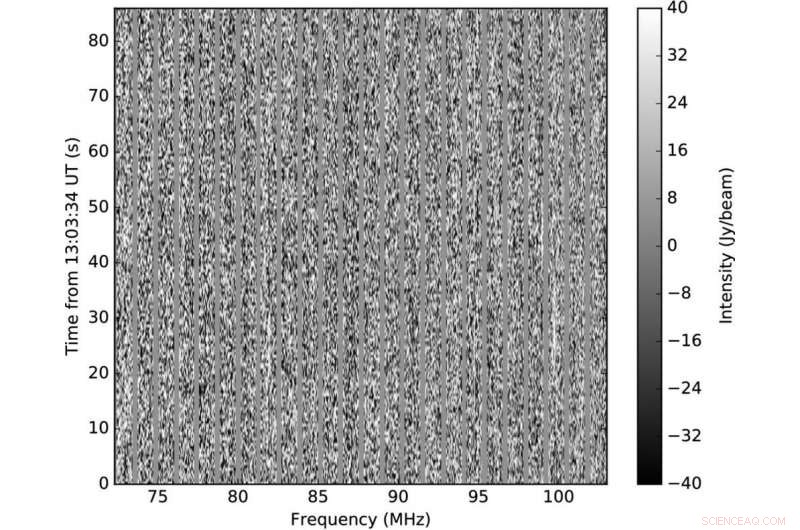
Data from the Murchison Widefield Array, showing no detection of radio signals from ‘Oumuamua in the frequency range 70-105MHz (containing the FM band). Credit:Steven Tingay and co-authors, Forfatter oplyst
It is unlikely that nature would produce such an extreme geometry. The authors quickly mention this, before moving to a discussion that, under the assumption that solar radiation is the cause for the acceleration, 'Oumuamua is artificial—that means the product of an alien civilisation.
The properties the authors derive under their assumptions are similar to those of solar sails being designed and built by humans as a possible way to travel interstellar distances.
Bialy and Loeb spend half of their article discussion section on the idea that 'Oumuamua could be a defunct or active solar sail belonging to an alien civilisation.
The nature and communication of evidence
Bialy and Loeb did not issue a press release about their study, but the media picked up the paper once it was accepted and available online, prior to this week's journal publication.
(This is something that happened to me in 2012, leading to my published non-detection of aliens being run on the front page of the BBC news website.)
Bialy and Loeb's publication attracted headlines such as this, for example:"Harvard astronomers claim Oumuamua is ALIEN PROBE - 'Nothing like we've ever seen!'". Most other reporting was more balanced.
This is pretty normal. A lot of the media jump to aliens in the reporting of space and astronomy, even when the original reported studies have never mentioned aliens. Recent reporting of Fast Radio Bursts (FRBs) is an example.
What surprised me was the reaction of some of my colleagues to Bialy and Loeb's paper. On social media, there have been some pretty personal attacks by scientists – on Loeb in particular – for being in the media for this work.
Both new studies lay out their assumptions, cite substantial evidence, and undertake rigorous calculations. Both were accepted by top-quality journals after independent peer review.
Both finish with bottom lines that the studies of 'Oumuamua are inconclusive and we will need to examine more such objects that come through the solar system in the future.
Both sets of authors also come up with different perspectives and motivate different questions. But Loeb has ended up in the media, talking about his paper, and is being panned by some colleagues for it.
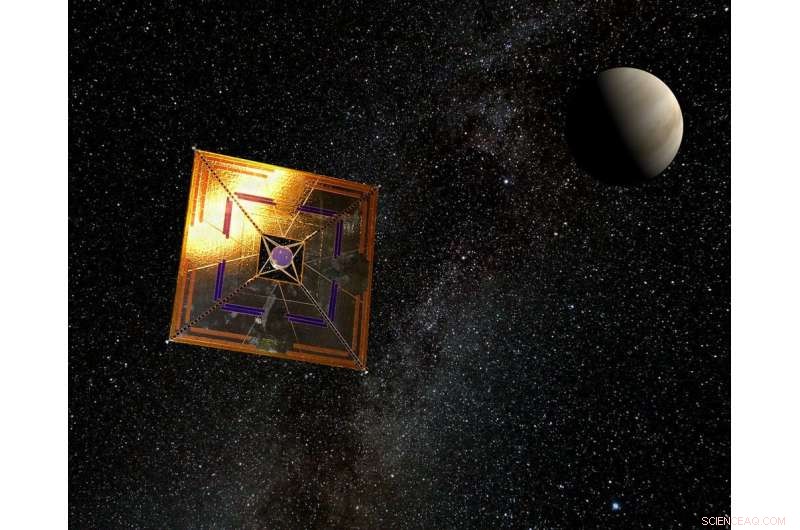
Artist’s impression of the IKAROS mission using a solar sail. Credit:Wikimedia/Andrzej Mirecki, CC BY-SA
Since the pre-journal paper was picked up he told me he has been swamped by media interest. "I use the discussions with the media as a platform for highlighting the standard scientific methodology:an anomaly is observed in data, the standard explanation fails to explain it, and so an alternative interpretation is proposed. I encourage anyone with a better explanation to write a paper about it and publish it. Wrong interpretations can be ruled out when more data will be released on 'Oumuamua or other members of its population in the future."
As for the negative reactions he has received, he referred to an article he recently published where he paraphrased another scientist known for his once-controversial theories. "As Galileo reasoned after looking through his telescope, 'in the sciences, the authority of a thousand is not worth as much as the humble reasoning of a single individual.'"
Let's talk about evidence
Given my work on observations of 'Oumuamua, a few journalists have contacted me for comment.
These have been great opportunities to discuss in depth with journalists the nature of evidence, the difference between something being consistent with observations and direct evidence for a conclusion, and the need for evidence to be commensurate with the impact of a claim.
If aliens are claimed, direct and robust evidence is required – not a conclusion based on a few observations that are difficult to explain, plus a bunch of assumptions.
But no scientist has claimed 'Oumuamua is alien in this discussion – they have just raised questions and explored answers.
There is no point in shying away from a proper discussion on the search for extraterrestrial intelligence, or in being personally critical of colleagues.
Scientists should take every opportunity to engage with the public and the media on the topic, given the public's interest and the media's willingness to report.
It is interesting, fun, and scientific, and a great opportunity to discuss the scientific method and science in an engaging manner. The media reporting of 'Oumuamua shows that (aside from a few headlines), the content of reports is generally pretty good and responsible.
Whatever 'Oumuamua is (almost certainly not made by aliens, in my view), it is a fascinating object and presents lots of interesting scientific questions that will trigger further studies and observations.
We will never see 'Oumuamua again, and we may never know exactly what it is. But seeing 'Oumuamua in the news is likely to inspire some kids to take up a career in science.
Denne artikel er genudgivet fra The Conversation under en Creative Commons -licens. Læs den originale artikel. 
 Varme artikler
Varme artikler
-
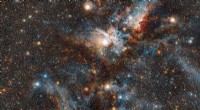 Stjerner vs. støv i Carina-tågenDette spektakulære billede af Carina-tågen afslører den dynamiske sky af interstellart stof og tyndt spredt gas og støv som aldrig før. De massive stjerner i det indre af denne kosmiske boble udsender
Stjerner vs. støv i Carina-tågenDette spektakulære billede af Carina-tågen afslører den dynamiske sky af interstellart stof og tyndt spredt gas og støv som aldrig før. De massive stjerner i det indre af denne kosmiske boble udsender -
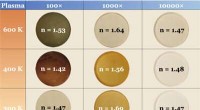 Uklarheden af exoplanetatmosfærer afhænger af egenskaberne af aerosolpartiklerForskere målte brydningsindekserne ved synlige bølgelængder (n) for uklarhedsprøver skabt under en række forhold. Kredit:Yu et al., Natur astronomi, 2021 Mange exoplaneter har uigennemsigtige atmo
Uklarheden af exoplanetatmosfærer afhænger af egenskaberne af aerosolpartiklerForskere målte brydningsindekserne ved synlige bølgelængder (n) for uklarhedsprøver skabt under en række forhold. Kredit:Yu et al., Natur astronomi, 2021 Mange exoplaneter har uigennemsigtige atmo -
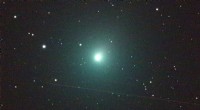 Se en forbipasserende komet denne søndagDette 120 sekunders billede af kometen blev taget den 2. december af en iTelescope 50 mm refraktor placeret ved et observatorium nær Mayhill, Ny mexico. Striben under kometen blev frembragt af et rake
Se en forbipasserende komet denne søndagDette 120 sekunders billede af kometen blev taget den 2. december af en iTelescope 50 mm refraktor placeret ved et observatorium nær Mayhill, Ny mexico. Striben under kometen blev frembragt af et rake -
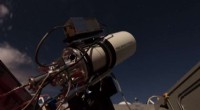 Nyt infrarødt teleskop først til at overvåge hele den nordlige himmelGattini-IR teleskop. Kredit:Gattini-IR-teamet Et nyt infrarødt teleskop designet og bygget af astronomer ved ANU og California Institute of Technology (Caltech) i USA vil være det første af sin sl
Nyt infrarødt teleskop først til at overvåge hele den nordlige himmelGattini-IR teleskop. Kredit:Gattini-IR-teamet Et nyt infrarødt teleskop designet og bygget af astronomer ved ANU og California Institute of Technology (Caltech) i USA vil være det første af sin sl
- Sådan konverteres 12 Volt Generator til 120 Volt
- Hvorfor gik Saber Tand Tiger ud?
- At betale skat mindre skat, når vi erkender, hvordan disse dollars hjælper andre, undersøgelse fi…
- Hvorfor Arktis ikke er et globalt fællesområde
- Aircondition i et skiftende klima:En voksende rig-fattig kløft
- Curiosity Mars rover tager en ny selfie før rekordstigning


